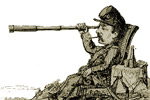
STOP #6
MEADE'S HEADQUARTERS SIGNAL STATION |

This was the central station on the field and was key in
receiving the various reports from Little Round Top and the other signal
stations. Maj. Gen. Butterfield was provided information on the movement of
Longstreet's Corps on the afternoon of 2 July by flag signals between this
station and the one on Little Round Top. On 3 July the station was used
extensively. The Chief Signal Officer explains:
Report of Capt. Lemuel B. Norton, Chief Signal Officer, Army of the
Potomac:
The station at General Meade's headquarters and that of General
Howard's were rendered inoperative for a couple of hours by the furious
attack of the rebels upon our center, but both were again actively employed
as soon as the tremendous fire moderated sufficiently to permit of messages
being read and transmitted with accuracy. The station on Round Top continued
to report throughout the day discoveries in regard to the enemy's position
... I take pleasure in still further mentioning Capt. D. E. Castle, of this
corps, for distinguished gallantry and close attention to duty under most
trying circumstances. On July 3, when the enemy made their furious attack
upon our center at Gettysburg, Captain Castle occupied a signal station at
General Meade's headquarters, near Cemetery Hill, and remained there on duty
after all others had been driven away. His flagmen had also left with his
signal equipments, under the impression that their officer had gone with the
rest. Having occasion to send a couple of important messages to the general
commanding, then at General Slocum's headquarters, Captain Castle quickly
cut a pole, extemporized a signal flag from a bedsheet procured near by, and
sent his dispatches through under a most galling fire.
[O.R., XXVII, Part III, pp. 203-2061]
Maj. Gen. Meade, in a letter written to John B.
Bachelder after the war, explains the circumstances of his leaving this
location to go to Slocum's headquarters and he describes the role the signal
stations had in that decision.
On the 3d of July, 1863, when the enemy's batteries were opened,
I was at the house on the Taneytown Road occupied by me as head-quarters.
This house, as you are aware, was situated about three or four hundred yards
in the rear of the line of battle, and about the center of the enemy's
converging lines of fire. Having around me a large number of officers and
animals, exposed without any particular necessity to the very severe fire,
the question of moving my head-quarters to a position less exposed was
repeatedly brought to my notice; but in view of the importance of my being
where it was known I could be found, I felt compelled to decline listening
to any appeals till informed there was a signal officer on the hill on the
Baltimore pike (occupied as head-quarters by Major-General Slocum) who could
communicate with the signal officer at the head-quarters I was occupying, I
ordered head-quarters to be transferred to this hill. Prior to doing so, I
moved over to a barn on the opposite side of the Taneytown Road, which
seemed to be out of the line of the heaviest f-ire, but which, on reaching,
was as much exposed as the place I had left. On arriving at the hill
selected, I at once went to the signal officer on the summit, and directed
him to communicate my arrival to the officer I had left at the house. I then
ascertained the signal officer at the house had left there. As soon as I
learned this, I returned immediately to my old head-quarters.
[George G. Meade, Letter to John Bachelder,
Descriptive Key to the
Painting of the
Repulse of Longstreet's Assault at the Battle of Gettysburg,
New York, John B. Bacheider, 1870, P. 61.]
Based on the
accounts of both Capt. Castle and Maj. Gen. Meade, it appears that Meade had
left the Power's Hill location before Castle made his improvised attempt to
signal Meade. This event does show that the use of flag signals did figure in
Meade's resources for command and control. The fact that Castle was still at
this station after Meade's departure appears to be substantiated by the
account of Lieut. Haskell of Gibbon's staff:
The General said I had better "go and tell General Meade of this
advance". To gallop to General Meade,s headquarters, to learn there that he
had changed them to another part of the field, to dispatch to him bv the
Signal Corps in General Gibbon's name the message, "The- enemy is advancing
his infantry in force upon my Eront," and to be again upon the crest, were
but the work of a minute.
[Frank A. Haskell, The Battle of Gettysburq,
Edited by Bruce Catton, Boston, Houghton Mifflin Company, 1958, p.
101.]
This is the last stop on the battlefield. The remaining
stops visit signal station sites which were a part of Army of the Potomac's
movement within the campaign. Return to your automobile and drive to STOP 7.
To Stop #7, drive toward the center of GETTYSBURG and- turn left on FAIRFIELD ROAD (HWY 116). Drive 9.3 miles passing through FAIRFIELD and turn right on JACK'S MOUNTAIN ROAD. (Jack's Mountain road is not marked. There is (was?) a large billboard advertising the Gettysburg Game Park at the turn-off.) Drive 1.3 miles and turn left on PINEHILL ROAD and take the first right on WARREN ROAD. Drive about 100 yards and stop at the intersection of WARREN ROAD and GLADYS ROAD. Park your car there and stand by the telephone pole.
|




